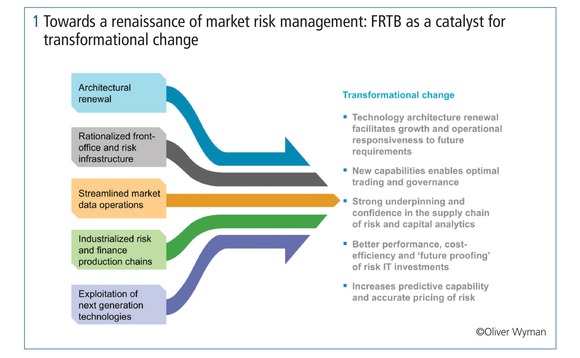
This article was paid for by a contributing third party.More Information.

Thinking differently about FRTB

Technology transformation is about thinking strategically and beyond the risk management function, says Satyam Kancharla, chief strategy officer at Numerix. Building a successful enterprise-wide response to FRTB and other regulations depends upon it.
 Satyam Kancharla, chief strategy officer, Numerix
Satyam Kancharla, chief strategy officer, Numerix
The pain points of the Fundamental review of the trading book (FRTB) are many and complex. Even more challenging is understanding how all incoming regulations correlate or conflict with each other from an operational standpoint.
Firms must start to think differently about FRTB. Beyond thinking purely of compliance to the regulatory standards, they must now consider it on a firm-wide enterprise level in terms of how these new capital market risk rules are broadly impacting front-office operations, risk management and data management functions, as well as treasury operations.
The net impact of FRTB goes beyond risk management functions, and the winners will be those who can transform to optimise across market dynamics, capital requirements and other regulations such as the Volcker rule, the Comprehensive Capital Analysis and Review, and Basel II.5 and III.
Under FRTB, we will continue to see downward pressure on bank return-on-equity, compounded by the potential need for additional capital given a 40–140% increase in capital requirements. Additional challenges on trading and market-making businesses may lead to banks exiting certain asset classes – something we are already starting to see. Reduced liquidity in certain asset classes will lead to hedging challenges both for the buy side and sell side, as well as increased residual risk in books. As a result, trading needs to become even more capital-aware, perpetuating the expansion of derivatives valuation adjustments to cover additional costs.
Though under the spotlight because of FRTB, these impacts are systemic, stressing a need for operational efficiency, reduction in costs and automation throughout the entire value chain.
Is FRTB a real opportunity for transformational change? Institutions must carefully consider this question. If so: what will that look like? What decisions need to be made now, and what needs to be in place for the long term?
Building a successful enterprise architecture for the future starts with the creation of a technology blueprint that can support this transformation. As banks are seeking to change, so must their underpinning technology.
The distinction between developing a comprehensive strategy to transform processes and technology and putting in place purely tactical fixes lies in whether affected functions are truly engaged in the process. IT transformation teams need to design globally and implement locally.

On the path towards developing an FRTB implementation strategy, the ‘band-aid’ approach will not be effective for long-term success, and institutions must ensure their transformation strategy is optimal from both an investment and capital perspective.
Banks must take ownership of rising costs and understand the business impact of FRTB. Financial institutions must make key decisions to support the front office, risk, treasury and compliance more holistically – although some of these decisions could be painful for management, especially in terms of transforming analytics and technology frameworks.
Before strategic decisions are finalised, institutions can take clear first steps to assessing the overall business impact of FRTB – including understanding capital charges – how FRTB is impacting each of their desks from a profitability standpoint and how operational risk and market risk are coming into play. Which business lines will utilise the standardised approach as opposed to the internal model-based approach, and what is the potential business impact of each? By asking the right questions and having the right strategy in place, executives and heads of trading and risk can quickly and efficiently obtain a clear picture of FRTB business impact today and into the future.
Read/download the article in PDF format
Sponsored content
Copyright Infopro Digital Limited. All rights reserved.
As outlined in our terms and conditions, https://www.infopro-digital.com/terms-and-conditions/subscriptions/ (point 2.4), printing is limited to a single copy.
If you would like to purchase additional rights please email info@risk.net
Copyright Infopro Digital Limited. All rights reserved.
You may share this content using our article tools. As outlined in our terms and conditions, https://www.infopro-digital.com/terms-and-conditions/subscriptions/ (clause 2.4), an Authorised User may only make one copy of the materials for their own personal use. You must also comply with the restrictions in clause 2.5.
If you would like to purchase additional rights please email info@risk.net